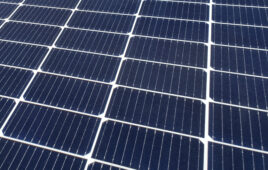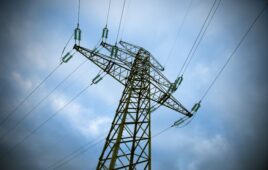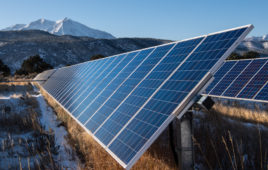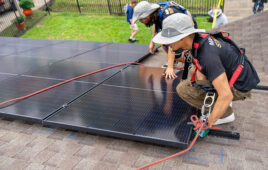A few months ago, the EPA and U.S Department of Energy’s National Renewable Energy Laboratory announced their decision to join forces in evaluating sites that could be used for renewable-energy production. Since then, wind turbines have risen from abandoned toxic industrial sites, and solar panels have begun to catch rays over contaminated landfills. Here’s an update from NREL on what’s happened so far.

NREL engineer James Salasovich checks his SunEye, a device that analyzes shade to help determine a site's solar energy potential. It can distinguish between trees, clouds and shaded contours. Credit: Pat Corkery
- America’s eyesores are becoming the hot places to install renewable energy for electric power generation. The land is cheap, often abandoned but properly zoned. They’re usually close to necessary infrastructure such as power lines and roads, and no other developers are rushing to erect anything on them. The U.S. Department of Energy’s National Renewable Energy Laboratory (NREL) is evaluating sites for renewable energy potential on behalf of the EPA.
“The big driver is using land that otherwise couldn’t be used,” says James Salasovich, an NREL engineer. Salasovich has evaluated so-called landfill brownfields in Puerto Rico and Wisconsin. “Google Earth will tell us the area of the landfill, but to get a good idea of where the hills and shading obstacles are, you really have to visit the site,” he adds.
Brownfields could be former industrial sites abandoned when the owners went bankrupt. There might have been paint or fuel spills there, but the exact source of contamination may be unknown. However, superfund sites usually have a responsible party identified. Some brownfields are ready for redevelopment, but others need a lot of work first.
Photographing the sky for its solar potential
Salasovich and other traveling NREL engineers start with a device called a SunEye, which has a fish-eye lens to photograph the sky above the landfill. “We point it south and take a photo,” he says. “It puts out a spherical graph and shows where the shade will be by what time of day and what time of year.” An algorithm built into the device can detect differences between the sky and a tree.
If a site has wind potential, the engineers install a meteorological tower with instruments to read wind speed and direction, according to Joseph Roberts, an engineer with the National Wind Technology Center at NREL. After 12 months of measurements, they can find an average speed and see how it compares with data from nearby airports. Crew members also check the distance to the nearest roads and transmission lines, evaluating the sites’ potential for generating renewable energy and making it work economically.
NREL Engineers select potential plots from the EPA’s list of superfund and brownfield sites, as well as those identified by the Resource Conservation and Recovery Act (RCRA). In some cases, the renewable energy apparatus in construction is powering the ongoing clean-up efforts at the sites. In other cases, the wind turbine, solar array, or hydro power is sending power to nearby cities. This is most feasible when the site is close enough to transmission wires to tie into the grid. There are about 11,000 sites in the U.S. with some past or current environmental contamination problem that may hold potential for renewable energy, according to Gail Mosey, senior energy analyst in the Strategic Energy Analysis Center. She says it’s a great opportunity to reuse land for power generation without help from fossil fuels.
Erecting devices without disturbing the contamination
Some sites, particularly superfund sites, are so contaminated with toxic chemicals and heavy metals that the earth should not be disturbed. However, Mosey explains, “There are a lot of others that can endure a slight intrusion. There are workable solutions for installing renewable energy on the surface or outside the contaminated area.” For example, solar arrays fit comfortably on top of the two feet of dirt and liner that typically cover a condemned landfill.
There are even wind turbines (supported by surface-mounted concrete footing) that can generate energy without burrowing into the muck of a superfund site. “These are places where you wouldn’t necessarily want to put a housing development, pour a foundation, or have people plant backyard gardens,” Mosey says, “but they are excellent sites for renewable energy.”
-

NREL engineer James Salasovich and Gail Mosey, a senior energy analyst in NREL's Strategic Energy Analysis Center, check measurements from the SunEye, a device that is useful in assessing solar energy potential above contaminated sites. Credit: Pat Corkery
Site clean-up efforts
- The NREL sometimes work on the superfund site even before the final Record of Decision is issued. In those cases, the NREL suggests options. For example, there is a groundwater cleanup effort at the Leviathan Mine in California, where trucks haul petroleum up mountain roads to power the clean-up operations. “We told them they could cut back their trips if they installed a wind turbine or PV,” Mosey says. “This suggestion could be factored in the decision.”
A brownfield or other contaminated site can be a “blight” on a community, land that nothing else can be done with for a number of years. “It’s a constant reminder of what the former site was used for. Rather than just let it sit fallow, this presents an excellent opportunity for power generation,” he adds.
There are more than 4,000 brownfields in the U.S., a total of 37,000 acres equivalent to 28,500 football fields. Including RCRA, superfund sites, and abandoned mine lands, there are more than 11,000 sites on 14 million acres.
That’s enough room to power a large chunk of America with wind turbines and solar energy.
Of course, not all those acres are suitable for renewable energy. They could be too sloped, shady, or contaminated. NREL works to assess the properties at sites using screening criteria and conducting feasibility studies. This may include considering the renewable energy resource potential, if it’s close enough to transmission lines to feed the grid, near enough to graded roads to make a renewable energy installation, and the size of the site and slope of the land. “You need technical and economic feasibility,” Mosey says. “If it isn’t near transmission, a million-dollars-a mile transmission lines will be cost-prohibitive.”
Clean-ups sparked by passionate residents
Mosey and her teammates have seen the best of human nature emerging from some of the ugliest of landscapes. “We have citizens who are single-handedly making it happen,” she says. “They’re trying to make good out of bad.”
In the anthracite coal region of Pennsylvania, Peter Haentjens — whose family tried to pump water out of a huge coal field — is leading the effort to bring hydro power to the notorious Jeddo Tunnel. Workers dug the tunnel in the late 1800s to try to move water out of coal formations. The attempt backfired, sweeping dangerous heavy metals down with the acidic water. Today, the tunnel drains 33 square miles of coal basins, bringing 60 million gallons a day of contaminated water to the Little Nescopeck Creek watershed. “You get this orange residue out of the rock when water is picking up iron,” Haentjens says. “You get gray if it’s manganese and white if its aluminum, which is pretty toxic.” He says the residue kills most of the aquatic life in the streams for 17 miles.
All that flowing water can help run a downstream pump station for a sewage treatment plant, as well as power a school or other local buildings, even while engineers work on a long-term solution for the contaminated water – and try to find money to pay for it.
When the tunnel was built over a century ago, the dirt dug up was set on either side. That same dirt could help build a dam to raise the level of the water 35 to 40 ft, according to Haentjens. “We could get pressure to make 150 kW. That could bring in $120,000 of revenue per year,” he says.
He adds that because it’s mostly wetlands, it’s not really developable. However, the community would like to make an environmental park out of it. There would be an educational component for hydroelectric energy, as well as a history of the tunnel and the acid drainage, and its effect on the environment. “NREL is looking at the economic justification of doing that, of how much we can sell the energy for, and the cost of building the dam,” he says. “The focus is to create economic value while improving the environment.”

This holding pond at the shuttered Leviathan Mine in California is too contaminated for most uses, and is in full clean-up mode. NREL engineers have convinced officials there to erect wind turbines on the site to reduce the need to truck in diesel fuel each day to power the clean-up efforts. Credit: Joseph Roberts
- A next step
- In 2008, EPA awarded NREL $650,000 to conduct feasibility studies at 13 different projects, including one in Puerto Rico. Mosey hopes to expand the program so NREL can evaluate contaminated sites for other federal agencies such as the Bureau of Mines, the Bureau of Reclamation, and the U.S. Forest Service. “In a lot of cases, the land is cheap, maybe even owned by the state,” Mosey says. “They’re just happy to have some positive re-use and some sort of revenue-generation on it.”
National Renewable Energy Laboratory





Tell Us What You Think!